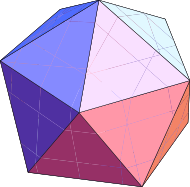There are five Platonic (regular) solids:
- tetrahedron, 4 triangular sides
- hexahedron (i.e. cube), 6 square sides
- octahedron, 8 triangular sides
- dodecahedron, 12 pentagonal sides
- icosahedron, 20 triangular sides
Each face of a Platonic solid must be a regular polygon and each face must be congruent. Also, the solid must be convex and the number of faces that come together at each vertex must be the same.
You can prove that the list above is complete by using Euler’s formula:
V – E + F = 2.
That is, the number of vertices minus the number of edges plus the number of faces equals 2.
Suppose you have a regular solid with F faces and each face has n sides. The number of edges E must be nF/2. This is because there would be nF edges if each face were separate. When we assemble the faces to make a solid we count each face twice.
Suppose that k faces come together at each vertex. Now the total number of vertices V must be nF/k. As before, each face separately contributes nF vertices. When we assemble the faces into a solid, each vertex is counted k times.
Putting these values in to Euler’s formula and doing a little algebra shows that
(2n – nk + 2k) F = 4k.
In particular, 2n – nk + 2k > 0. Also, the values n, k, and F must all be integers and at least 3. Those conditions limit the number of possible solutions to the five corresponding to the Platonic solids.
If n = 3, the condition 2n – nk + 2k > 0 reduces to 6 – k > 0, and so k could be 3, 4, or 5. These solutions correspond to the tetrahedron, octahedron, and icosahedron respectively.
If n = 4, the positivity condition reduces to 8 – 2k > 0. The only solution is k = 3 which corresponds to the cube.
If n = 5, the positivity condition is 10 – 3k > 0. The only solution is k = 3 corresponds to the dodecahedron.
If n ≥ 6, there are no solutions to the positivity condition. To see this let n = 6 + a and k = 3 + b where a and b are non-negative. Then 2n – nk + 2k = -a – 4b -ab which is clearly not positive.
This proves more than that there are only five Platonic solids. It shows, for example, that if you relaxed the requirement that the sides be regular polygons, you’d still get essentially the same solids.
For much more on Euler’s formula, see Dave Richeson‘s book Euler’s Gem.



